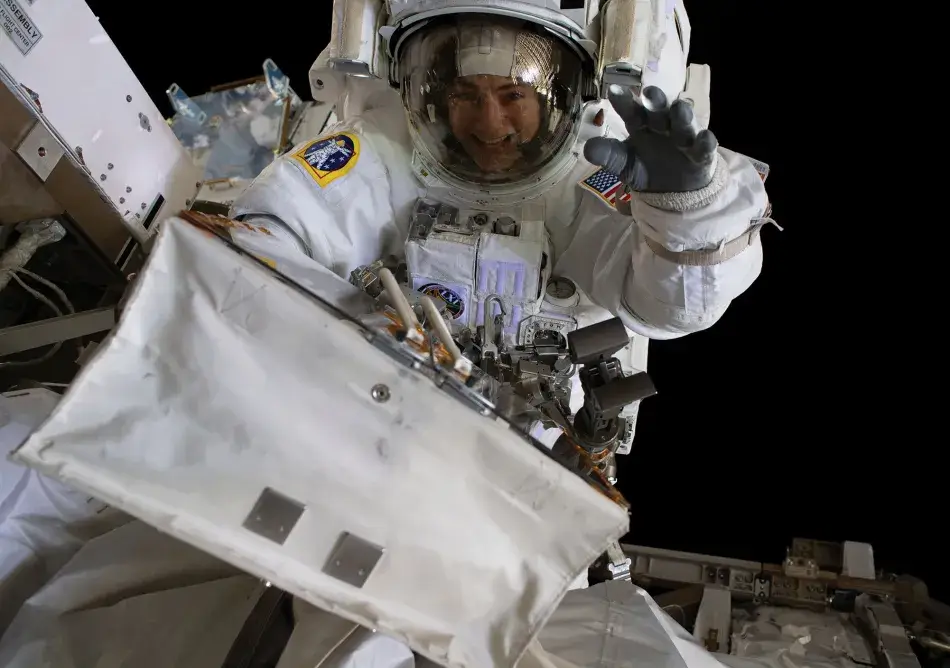
NASA astronaut Jessica Meir made history in October 2019 when she participated in the first all-female spacewalk. After 205 days in the isolation of space, she returned to a planet experiencing its own form of isolation: the global COVID-19 pandemic. As an astronaut and a marine biologist, Dr. Meir’s research into the impact of extreme environments has brought her to the depths of the Antarctic and the heights of space. At a virtual program, hosted by the Academy’s San Diego Program Committee, Dr. Meir described her research and her experiences in space and participated in a conversation with Brian Keating (University of California San Diego) about the perspectives that her work provides about our world. The program included opening and closing remarks by the San Diego Program Committee cochairs Geoffrey Wahl (Salk Institute for Biological Sciences) and Thomas Levy (University of California San Diego) and an introduction by Academy President David Oxtoby. An edited version of Dr. Meir’s presentation and conversation with Professor Keating follows.
2093rd Stated Meeting | December 2, 2020 | Virtual Event
Jessica Meir was selected by NASA in 2013. She holds a Bachelor of Arts in Biology from Brown University, a Master of Science in Space Studies from the International Space University, and a Doctorate in Marine Biology from Scripps Institution of Oceanography (UCSD). From 2000 to 2003, Dr. Meir worked for Lockheed Martin’s Human Research Facility, supporting human physiology research. During this time, she also participated in research flights on NASA’s reduced gravity aircraft and served as an aquanaut in an underwater habitat for NASA Extreme Environment Mission Operations (NEEMO). Dr. Meir most recently served as flight engineer on the International Space Station for Expedition 61 and 62.
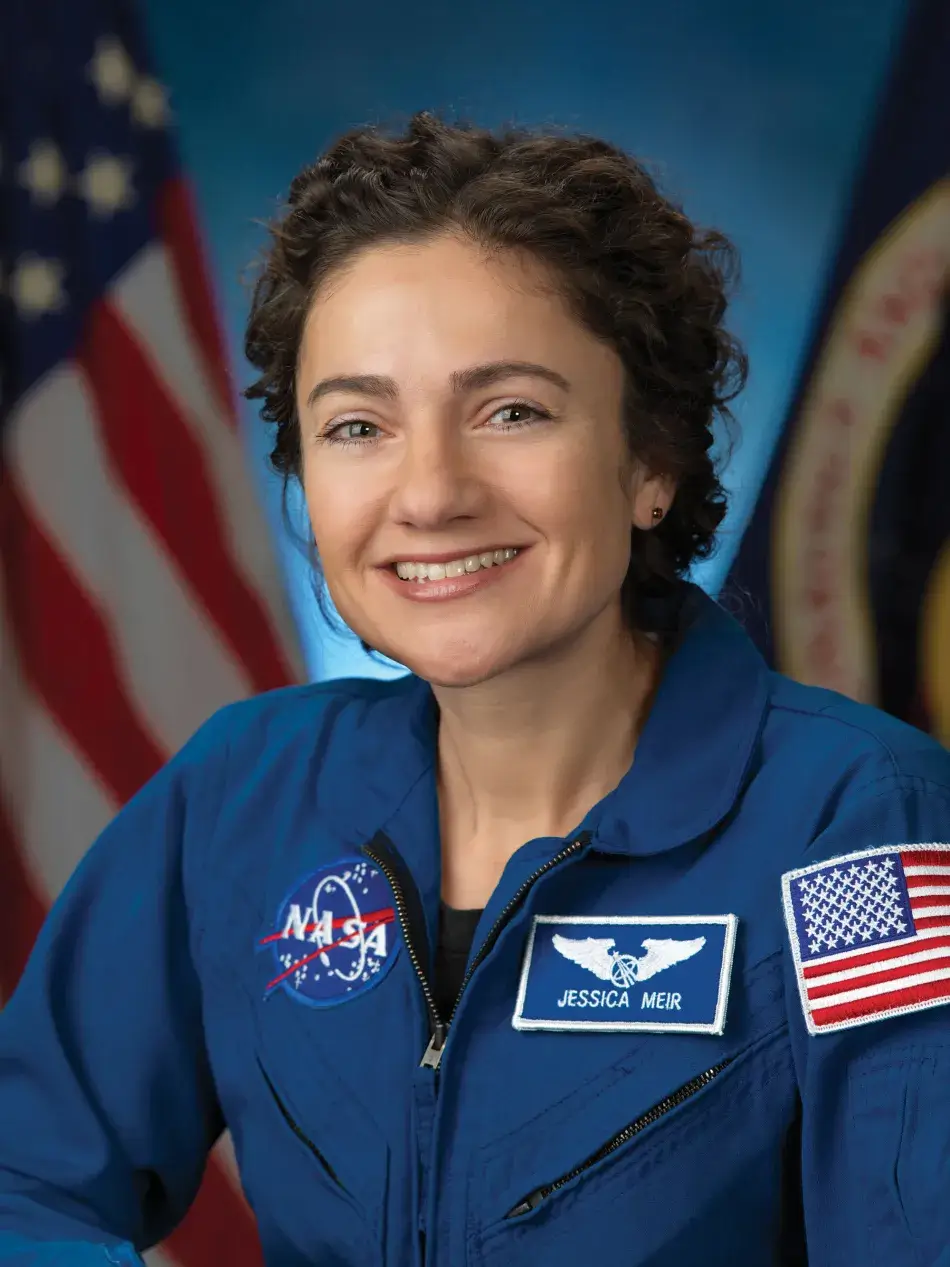
I was on the International Space Station for almost seven months: 205 days. I launched on a Soyuz spacecraft with the Russian Space Agency. (Soyuz is the name for both the rocket and the spacecraft.) I flew with my commander, Russian cosmonaut Oleg Germanovich Artemyev, as well as with the first astronaut from the United Arab Emirates, Hazzaa Al Mansoori, a historic component to our mission.
I was pretty excited. I don’t think my smile left my face for the whole, amazing seven months. Looking through the hatch and seeing all these familiar faces felt like home. One of the best parts about being in space is just the simple fact of living up there and floating all the time. Everything is so much more fun when you’re floating, like making a little charcuterie board. I’m a bit of a foodie down here on Earth. So in addition to all the rehydratable food and food that we heat up, I created a little charcuterie board with some extra cheese that had been sent up on a visiting vehicle. But everything is more fun: from eating and throwing food at your friends to drinking water. Some people think the gel-like substance they see floating in space can’t be water, but it is – there’s just no gravity to disrupt that surface tension.
Exercise is a very important part of working in the International Space Station. We would have significant bone density loss and muscle atrophy without it. We had a weight-lifting machine, treadmill, and cycle ergometer, and that is in addition to the daily life functions you might wonder about, like washing our hair and brushing our teeth in space. We had fun too: a few costumes for Halloween, a tribute to the Apollo 12 mission, and we celebrated the holidays up there as well. But, of course, the most important thing we do on the space station, and why I’m here tonight, is the science. The space station is a world-class international laboratory. We do scientific experiments ranging from physiological and medical experiments to combustion science, because even flames burn differently in space. We also support other projects, such as launching and deploying small satellites into Earth’s orbit.
We had a crop of mizuna lettuce on the space station. We were growing lettuce under two different wavelengths of light and using different fertilizers to assess their capabilities, which has a lot of applications for future sustainable food sources on long-duration missions. And in our life sciences glove box, we had lots of different types of experiments, from looking at bone cells to miniaturized muscles. We studied fluid shifts to the upper body in space and how this adaptation to space flight affects changes in vision. This research on the physiological effects of space flight will help prepare us for human travel to Mars. We had our own −80°C freezer, just like you might have in the lab, where we keep all of our samples. We did a lot of spacewalks during my mission, more than the usual. We did nine spacewalks in about a four-month period, which was really intensive, given the amount of maintenance that had to be done.
These included the first all-female spacewalk. I heard a rumor that Kathryn Sullivan might even be listening in tonight. I really need to pay homage to Kathryn and to all of the forerunners before us who paved the way. She was the first American woman to do a spacewalk many years ago. My walk with Christina Koch was the first time there were two women outside the space station at once. Christina and I did an upgrade for the batteries on the space station, replacing the older batteries with some newer lithium-ion batteries, just like the newer types of batteries you find in your cell phones and computers. We did three spacewalks together.
How do we resupply the space station? With visiting vehicles. Cargo resupply vehicles come up regularly to bring us food, new science, and supplies and hardware that we need. We capture those visiting vehicles using the Canadarm, a robotic arm on the space station. It’s kind of like flying an airplane while you’re driving a car, to grab a bird. We use the Canadarm to grab the vehicles and bring them in to dock with the space station, before unloading all of the cargo. We had a lot of visiting vehicles: Japanese cargo, SpaceX, and the Cygnus vehicles. And those vehicles become our trash cans when they depart, with the exception of SpaceX. SpaceX is the only one that can return samples and other hardware back to Earth. It splashes down in the ocean, while the other two burn up in the atmosphere. So we fill those ones with trash before we let them go.
Any free time we have is spent looking out the window and marveling at and taking photographs of the beauty of Earth below. We do that for science as well. We take Earth observation photos for different scientific imaging opportunities, including regular photos of the recession of glaciers. We flew periodically over Patagonia, so I was able to document some of that glacial retreat, comparing those images to the decades of imagery that we have now. And there are some really awe-inspiring views. It never gets old: flashes of lightning, all of the different city lights laid out, the Nile, the water source around which all nearby civilization is crowded. The Northern and Southern Lights are one of the most impressive things to see from the space station. It is like an otherworldly alien dance.
Unfortunately, the seven months passed much too quickly for my liking. I wasn’t ready to leave. But when it was time for our vehicle to depart, I had to get in. We landed in the Soyuz on land in Kazakhstan. Then we were picked up and flown back to Houston. I felt a little bit wobbly coming down the steps as I readjusted to gravity – and I was back.
Now I want to share a little bit from my perspective of what I call experimenting in microgravity and how, for someone like me who was a scientist with a scientific career on the ground before I became an astronaut, this really came full-circle.
Slide 1 (S1) shows a view from the International Space Station taken years before I was there. You can see that familiar shape of Cape Cod up there in the right corner as well as Caribou, Maine, where I was born. From the time that I was five years old, I wanted to be an astronaut. And the important thing here is that there wasn’t a particular event that made me say, “I know I want to be an astronaut.” It was really for me a combination of things. One being my love for nature and for biology and this fascination with the world around me. Growing up in a remote area surrounded by trees, outside skiing from early childhood, I was really fascinated by the diversity of the animal kingdom and the plants around me. And I just wanted to know more; I started asking those kinds of questions. It was that kind of inherent spirit of exploration that led me toward wanting to be an astronaut.
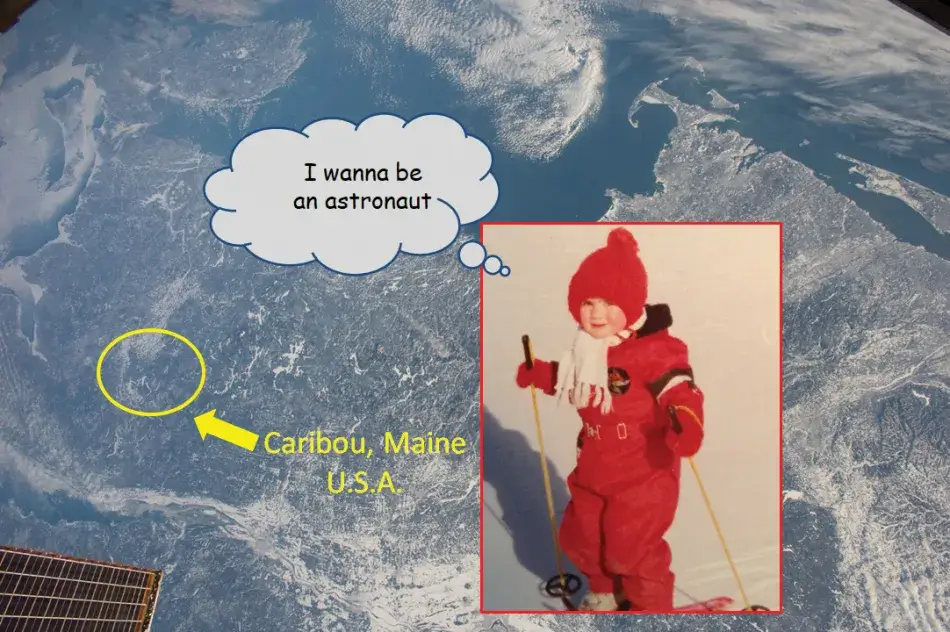
Of course, growing up as a child in the 1980s, we saw all of the shuttle launches on the evening news. We didn’t have the Internet then. We got our news sources either from the radio, the newspapers, or the evening news. And the shuttle program, rightly so, received a lot of attention. So it was a combination of those factors that really set that goal in my mind from the time I was five years old. In 1999 when I was a student about to graduate from Brown University, I had my first foray into microgravity research, and I began to connect my studies with my childhood love for biology. And even though it might not have been what people thought of as the most traditional path to becoming an astronaut, it was what I was passionate about. That’s what made it so important for me to pursue.
My undergraduate work at Brown was through NASA’s Reduced Gravity Student Flight Opportunities program, an incredible opportunity for undergraduate students to design an experiment and, if selected, fly their experiment on NASA’s Vomit Comet (S2). That is the airplane that flies in a parabola-type pattern in order to achieve brief segments of microgravity, about thirty-five seconds worth. And back in 1999, I had my first experience in weightlessness. It certainly was much different than the prolonged weightlessness of the space station. But in coming full-circle, this was a transition for me from being a student scientist at Brown and doing my first biological experiments for my honors thesis to then working in a laboratory as an undergraduate toward becoming a science coordinator (S3).
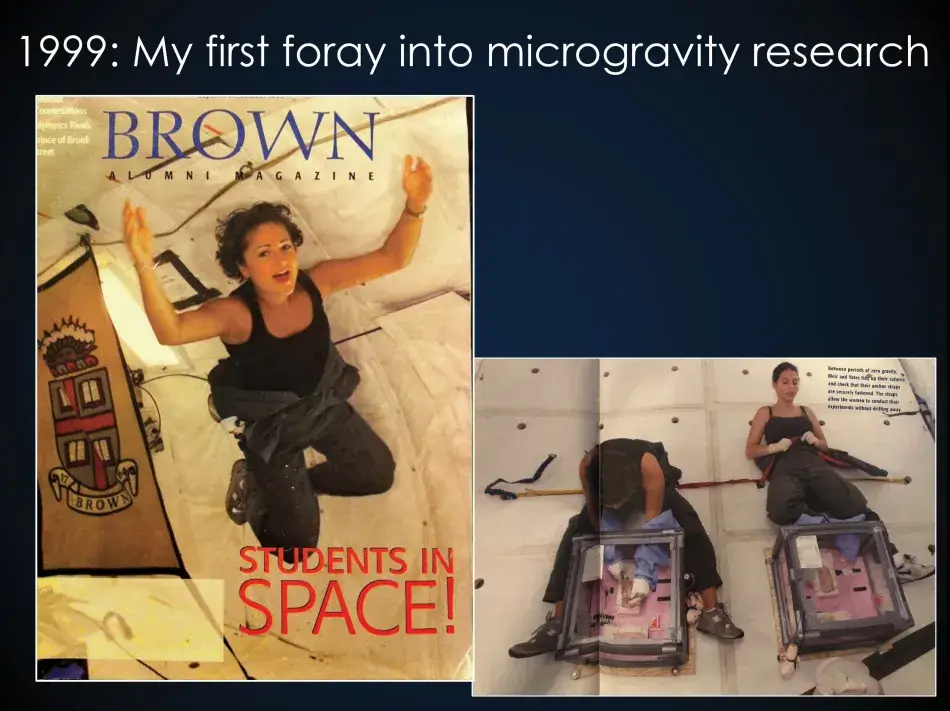
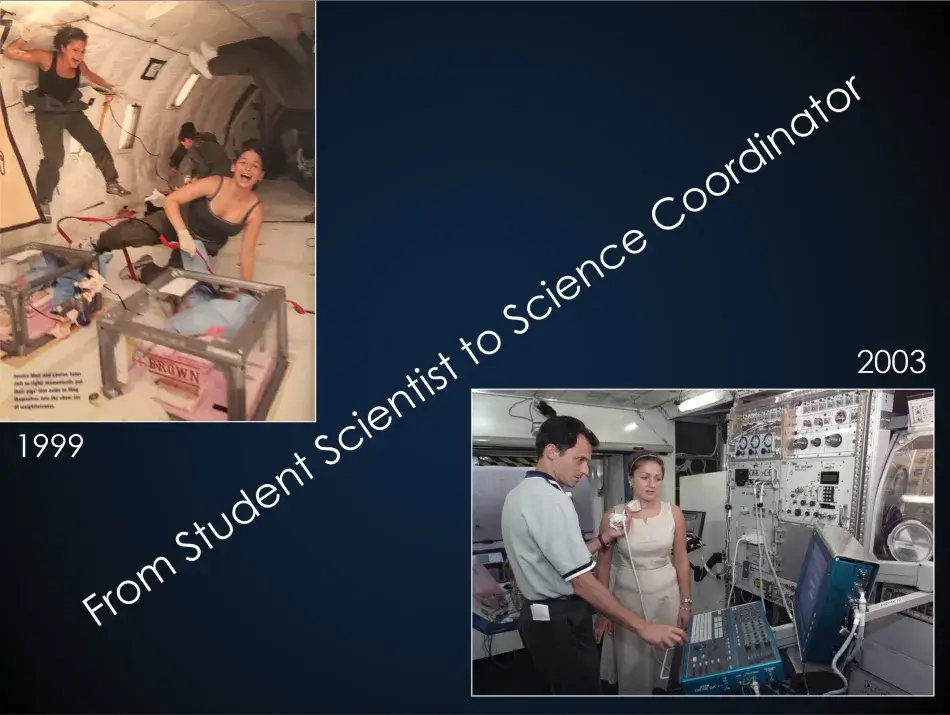
One of my first jobs was at the NASA Johnson Space Center. I worked as a support scientist organizing and coordinating experiments that were done on a space shuttle and the International Space Station.
So that was one of my first transitionary periods, moving from scientist to coordinating science that was led by other investigators all around the country and around the world that astronauts would perform in space. I had three years of experience and a lot of exceptional opportunities, including living, working, and training with astronauts underwater as a scientific representative in an underwater laboratory. But I got to the point where I thought, okay, I want to go back to school. I wasn’t sure exactly what it is I wanted to pursue. But after being underwater in this mission, doing some research in what was going on, thinking about pursuing a Ph.D. or going to medical school, and given my interest in biology, I found my next great interest: studying the physiology of animals in extreme environments.
So I moved on. I left NASA and all these exceptional experiences after three years and went to the Scripps Institution of Oceanography, where I pursued my Ph.D., looking at the diving physiology of exceptional divers, like deep-diving emperor penguins and elephant seals (S4). And those are the best divers in their categories. Everybody seems to be quite familiar with the harsh climate that emperor penguins deal with and their exceptional natural history; they’re pretty popular these days (S5). But I was most interested in them for their exceptional diving behavior. When you are lucky enough to see these animals diving beneath the sea ice in the Antarctic, they become different creatures. It is like watching a ballet underneath the surface of the ice. In particular, I was fascinated by these extreme behaviors. An emperor penguin can dive deeper and longer than any other bird: thirty minutes on a single breath of air.
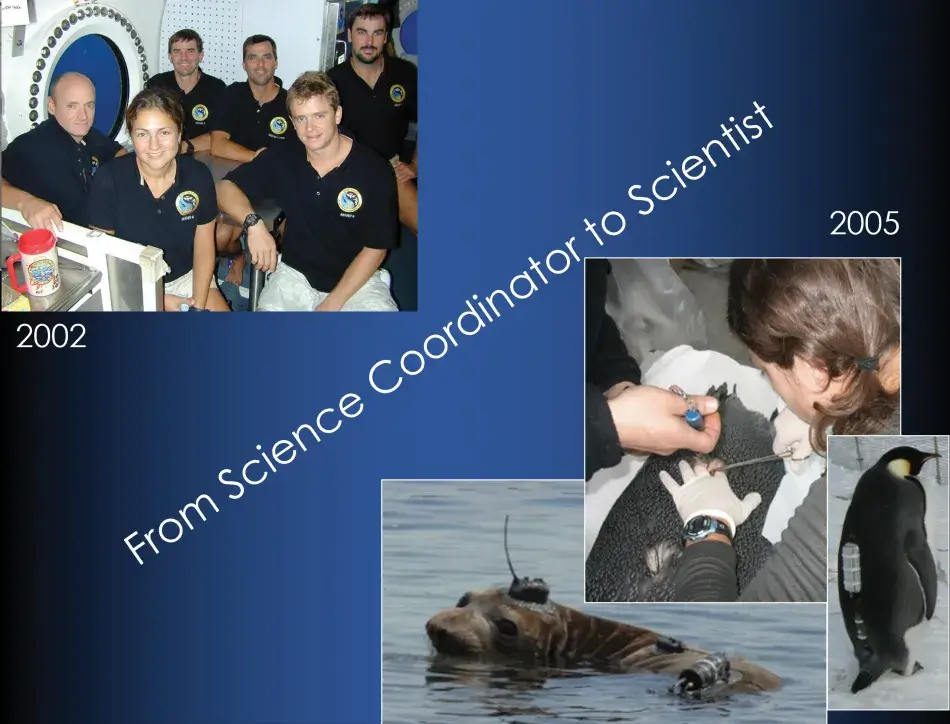
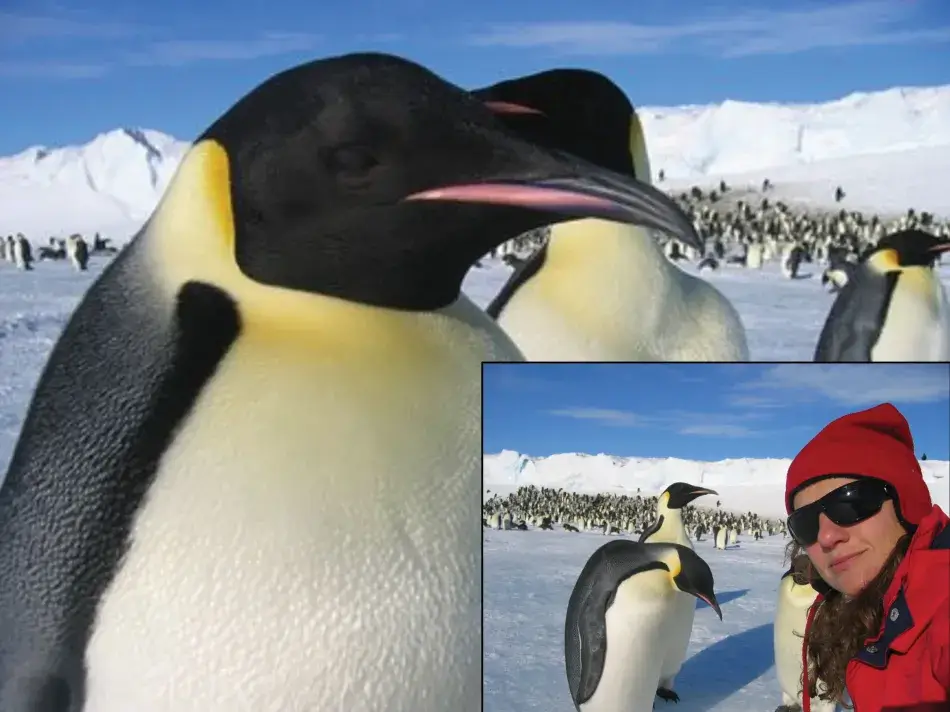
We were trying to understand more about their physiology that underlies that exceptional behavior. What is unique and special about them that enables that kind of exceptional diving capability? So we were doing things like putting heart rate recorders or oxygen electrodes into their blood vessels or into their respiratory system so that we could directly measure some of these parameters, to understand what’s going on with their entire physiology during dives (S6). I was fortunate enough to do some diving of my own down there (S7). If you ever have the opportunity, the Antarctic is absolutely the best place to dive on the planet. I also studied elephant seals, another extreme diver. They are the best diver of anyone in the pinniped world: that is, of seals and sea lions. They can hold their breath for two hours. So again, these are breath-holding, air-breathing mammals – just like us – but they can hold their breath for two hours. How is that possible?
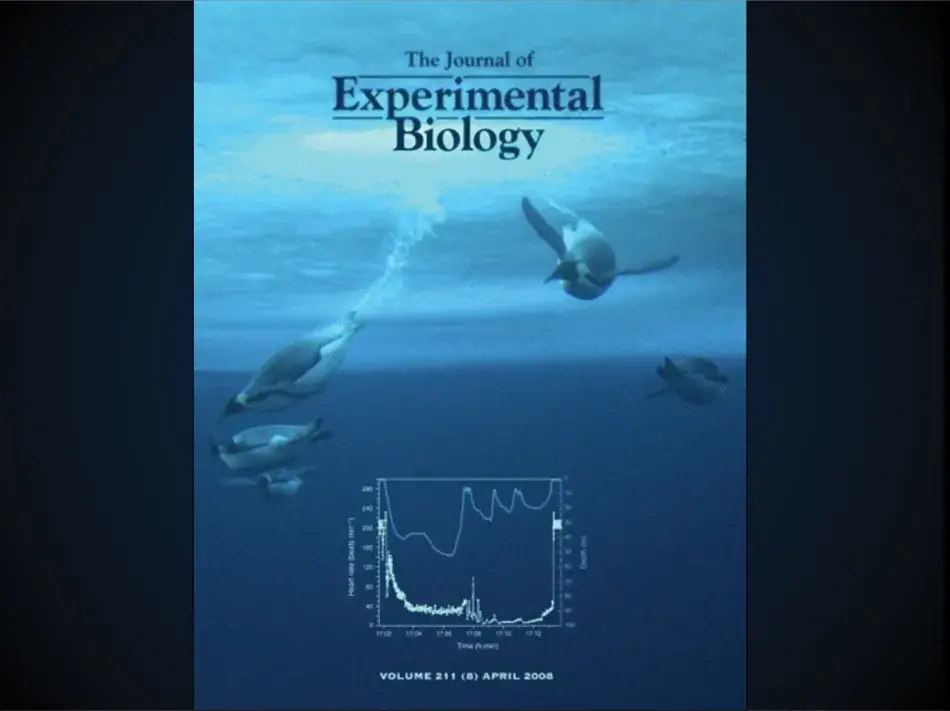
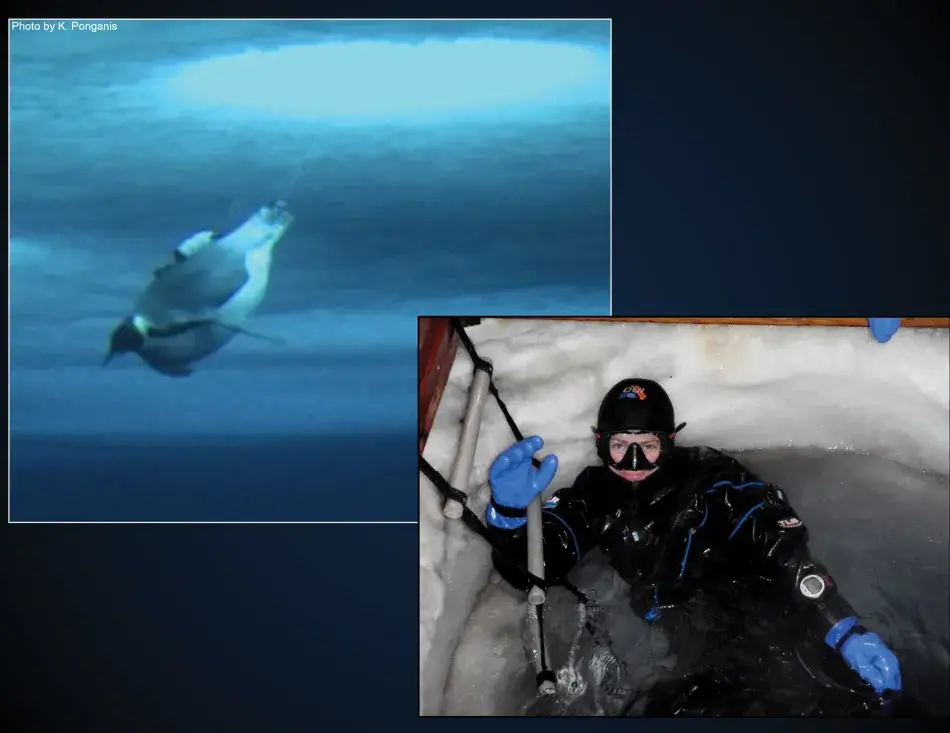
We did the same kind of studies putting instruments on these animals, tagging them, and letting them dive in their natural habitats to understand more about these exceptional behaviors (S8). Then I transitioned in my thinking: I love the field of diving physiology, it’s certainly something that I want to study more in the future, but I’m also really interested in broadening my skill set and experience and learning more about another extreme animal, the bar-headed goose (S9). It lives at the other extreme: it is the iconic species that migrates twice a year over the tallest mountains on the planet, the Himalayas. And we know that these animals must have some kind of adaptation to be able to support this flight. Flight is the costliest form of locomotion of any vertebrate. So how do they have this very high oxygen demand flying at an altitude where there is only half to one-third the amount of oxygen at sea level?
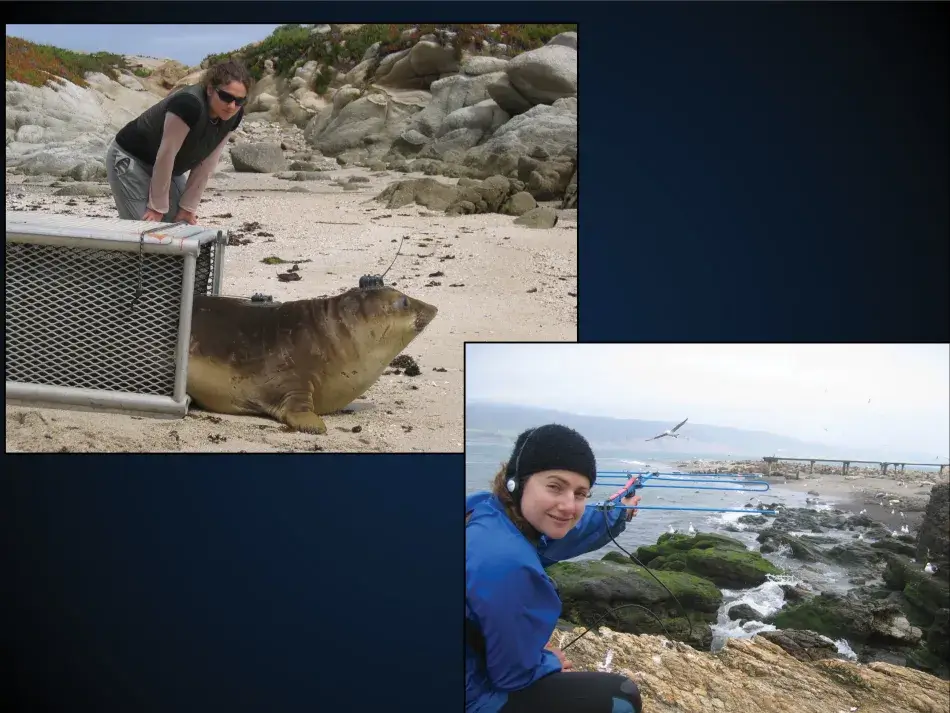
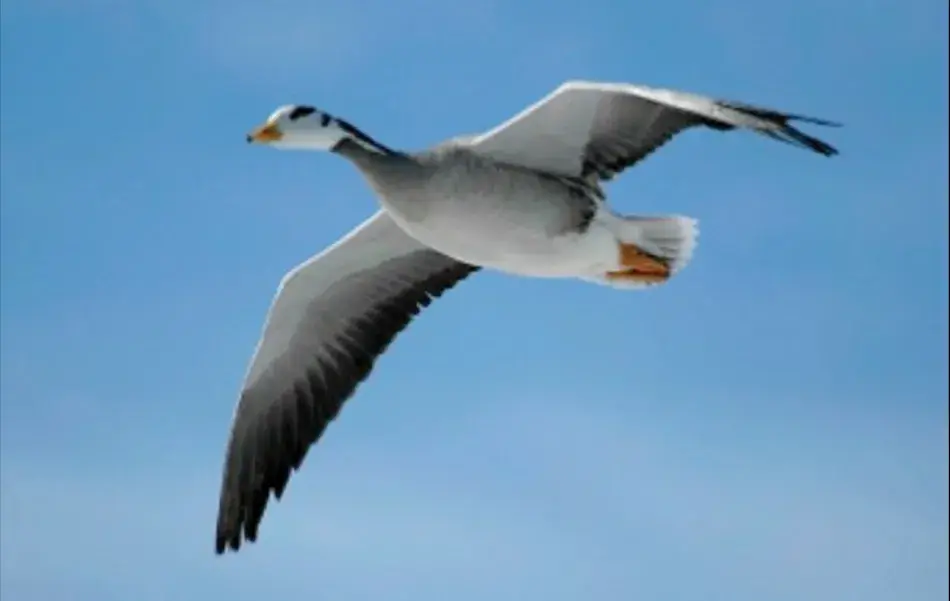
So a similar kind of problem. These animals are not, of course, holding their breath like the deep-divers. Instead they’re flying at such high altitudes that they only have a very limited oxygen supply. In order to study this, which I would say is perhaps the most ambitious thing I’ve ever done, including being an astronaut, I raised geese in order to have them imprint on me. Geese have this very strong imprinting instinct in which the first thing that they look at they see as their parental figure (S10). We took advantage of this in order to eventually train these geese to fly in a wind tunnel. And while I preferred to do these experiments in an animal’s natural habitat, some things you can’t measure in the wild. We were trying to understand the comprehensive physiology of these animals. What’s going on with their respiratory and cardiovascular systems?
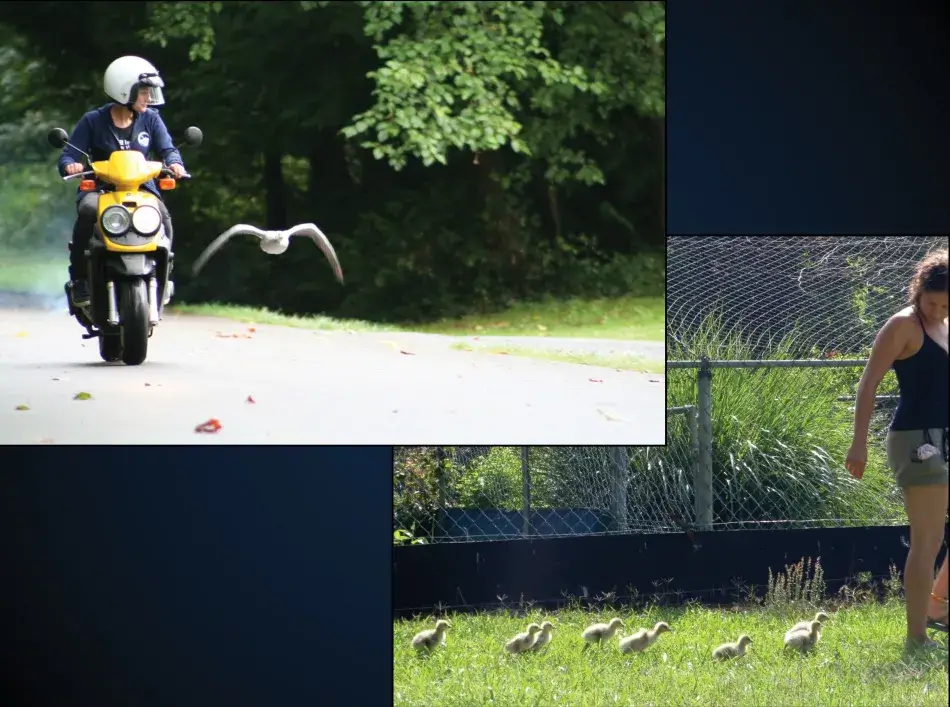
We were finally successful in flying these birds in the wind tunnel. And one bird was actually flying at 10.5 percent oxygen: half of what you would have at sea level. We were able to fly them all the way down to 7 percent. They were wearing a small mask that introduced nitrogen to lower that overall percentage of oxygen. I could talk about my research all night. But let’s continue with this scientific journey. And here is where the circle closes. Just in this past year I got my opportunity to go to the International Space Station where, finally, I transitioned from coordinating science and being the scientist who performs all of these elaborate experiments on animals to finally becoming the subject myself (S11).
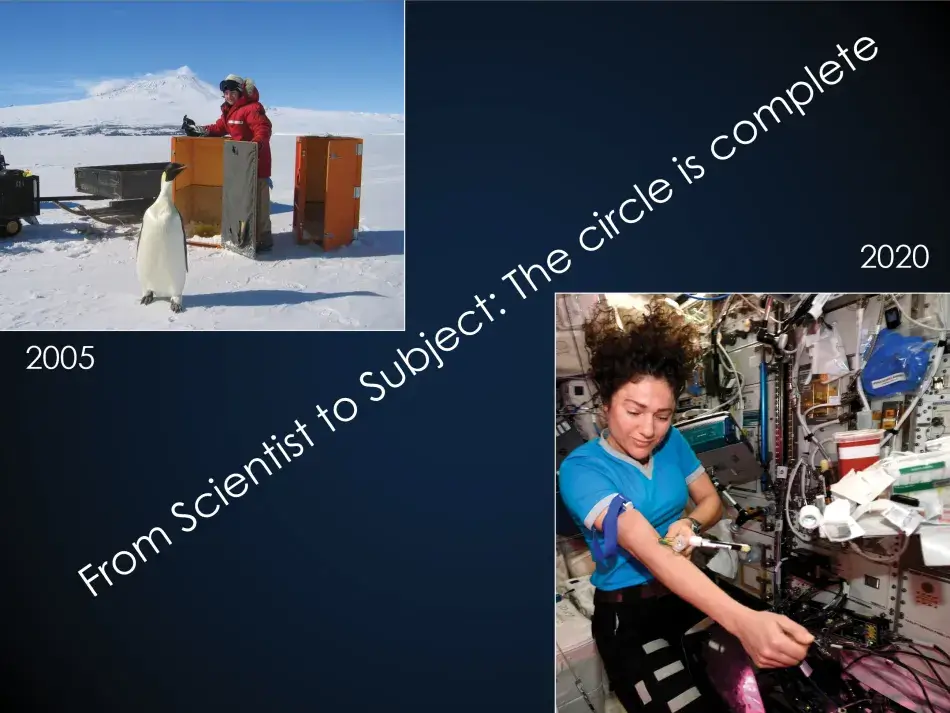
After all of the experiments that I did on these very willing subjects, it’s my turn to be the subject. And that involves a lot of very complicated, elaborate setups sometimes. This year I participated in an experiment called cerebral autoregulation wherein I’m monitoring a lot of different aspects of my physiology in space, mostly looking at the blood flow that’s delivered to the brain (S12). This was one of many different experiments that we did as human subjects on the space station. I used to train astronauts how to use an ultrasound back in 2003, and seventeen years later, here I am using an ultrasound on myself in space. It was another full-circle transition (S13).
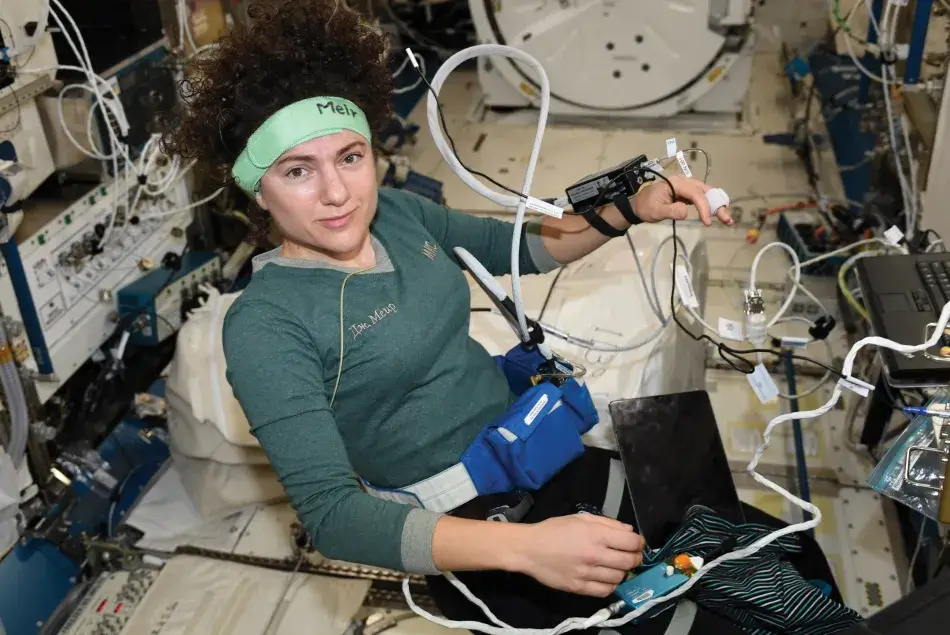
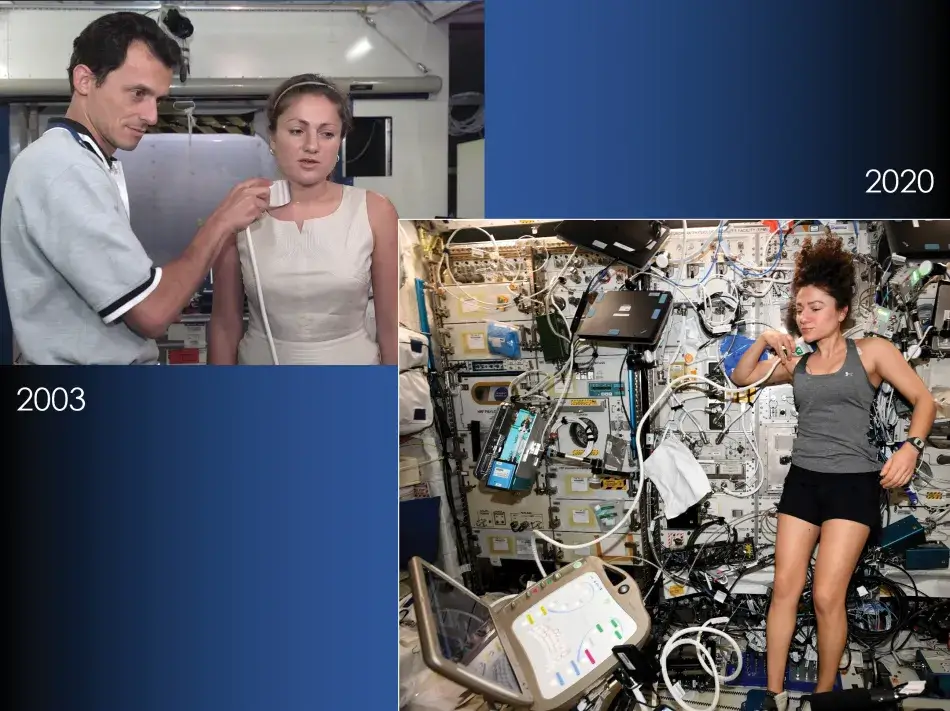
I mentioned earlier that we do all kinds of different science on the space station, including physiology medical experiments, combustion science, protein crystal growth, radiation, material science, really any type of system (S14). We have a summary of research statistics with working data as of April 30, 2020, from the International Space Station, representing all venues of science, from all of the International Space Station partners. Luckily for us, scientists need to publish or perish, and we do have some impressive publication statistics from the International Space Station as well.
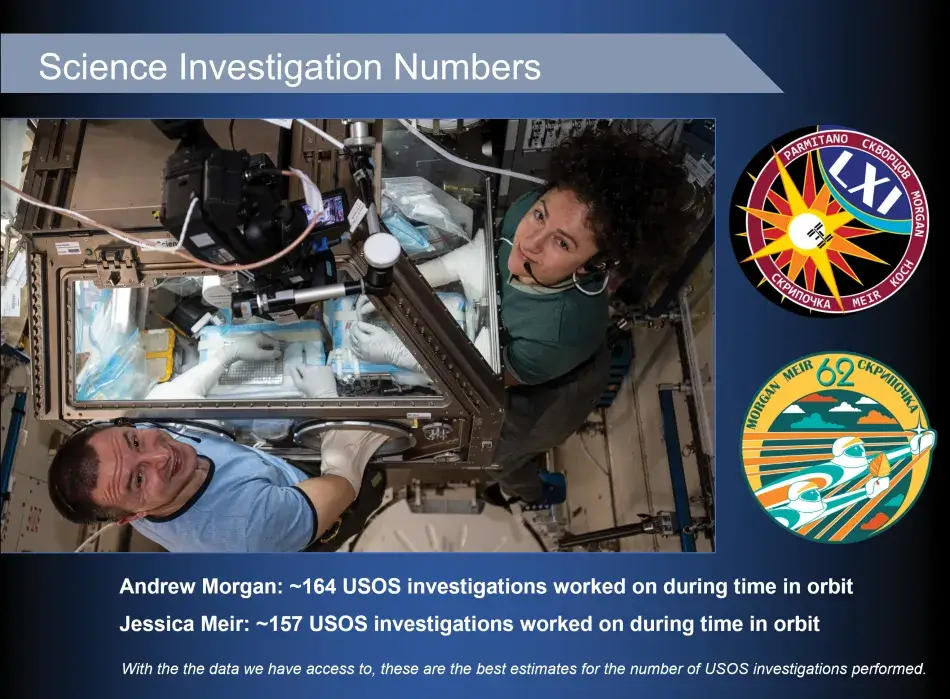
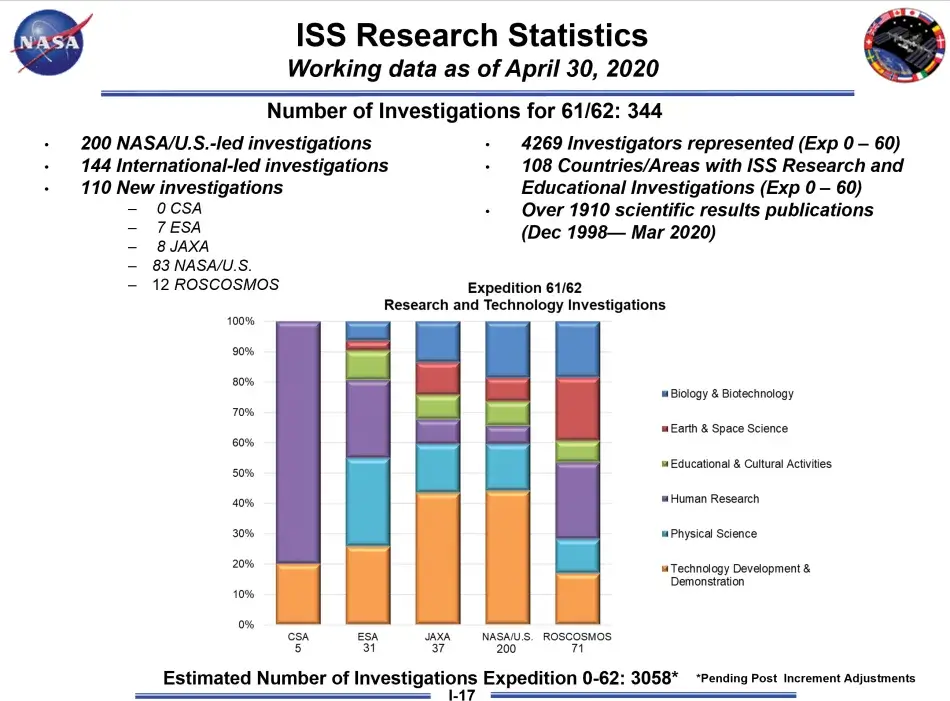
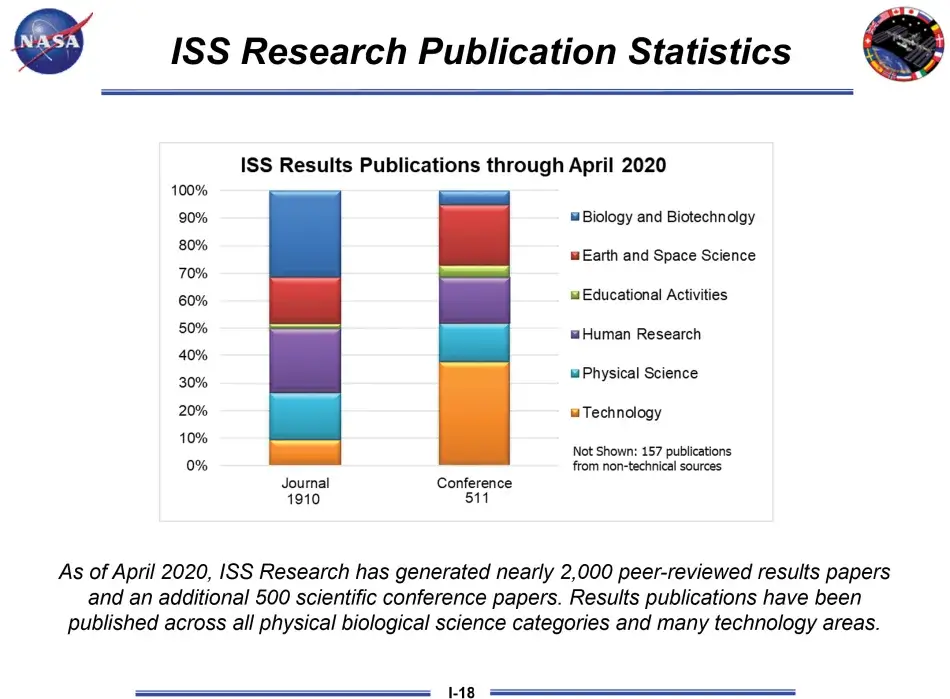
One last point: one of the great resources we have through NASA is this space station researcher explorer, which you can download onto your smart devices or access through nasa.gov. You can look up experiments by discipline or by name and find much more information about these particular experiments and opportunities to explore them further through benefits, facilities, and previous publications, as well as other Web resources.
So with that, I will end my portion of the talk, and we can launch into questions.
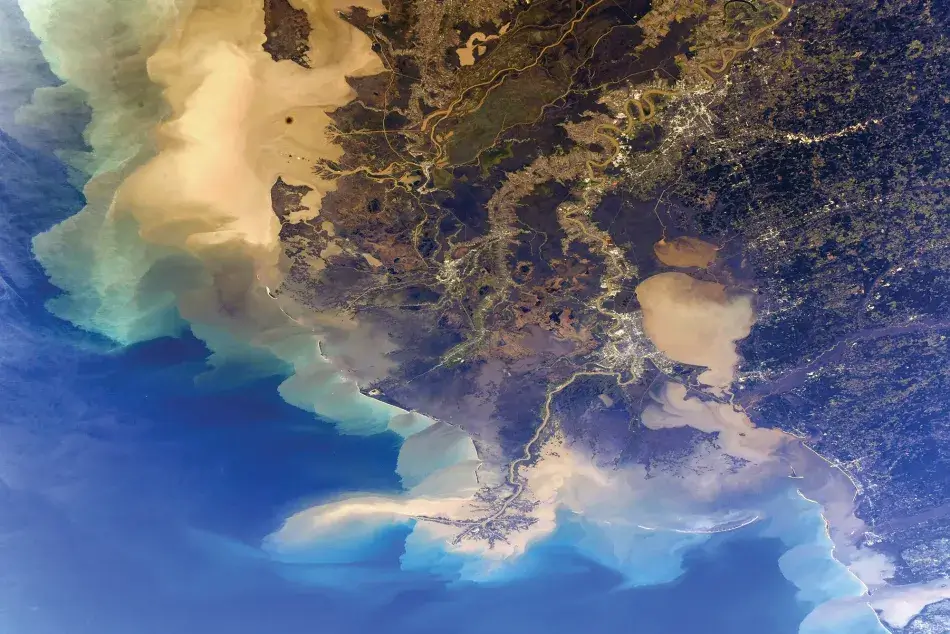
Jessica Meir: That’s right. I have to tell you, it was much more fun doing an interview with you while I was floating. But this is pretty great, too.
Brian Keating: First of all, I want to recognize that this is the twentieth birthday of the International Space Station. It was launched in 2000. It’s also the thirtieth anniversary of the Hubble Space Telescope. And Kathy Sullivan, one of our viewers who you mentioned earlier, is also the author of a phenomenal book called Handprints on Hubble. And she wants to say the following to you: “Thanks for the shout-out, Jessica, and kudos on a great presentation. Was super excited to watch your first EVA with Christina Koch.” “About time,” she adds. “Hope we can get together in person sometime next year to compare notes.” And she’ll buy the first beer.
Jessica, there are so many questions, but let’s start with the one I see the most often in the queue: how do you tweet from space?
Meir: Great question. Well, we do have the capability to have some normal Internet access. On the space station, we have an internal network that has all of the resources that we need to run the space station and to run our procedures. We can connect to the Internet given the appropriate satellite coverage as well. So we could just take our iPad – we don’t have our own phones up there, but we do have iPads – and tweet directly. We have an amazing support person on the ground, though, so what most of us do is, at the end of the day, whatever tweet or Instagram post I have, I will put it together, send it down to her, and then she’ll have much better coverage than I do up there. And she’ll take a look, make sure everything’s correct, and she’ll put it out there. So I did do all my own social media but the actual, physical posting was done by our person on the ground.
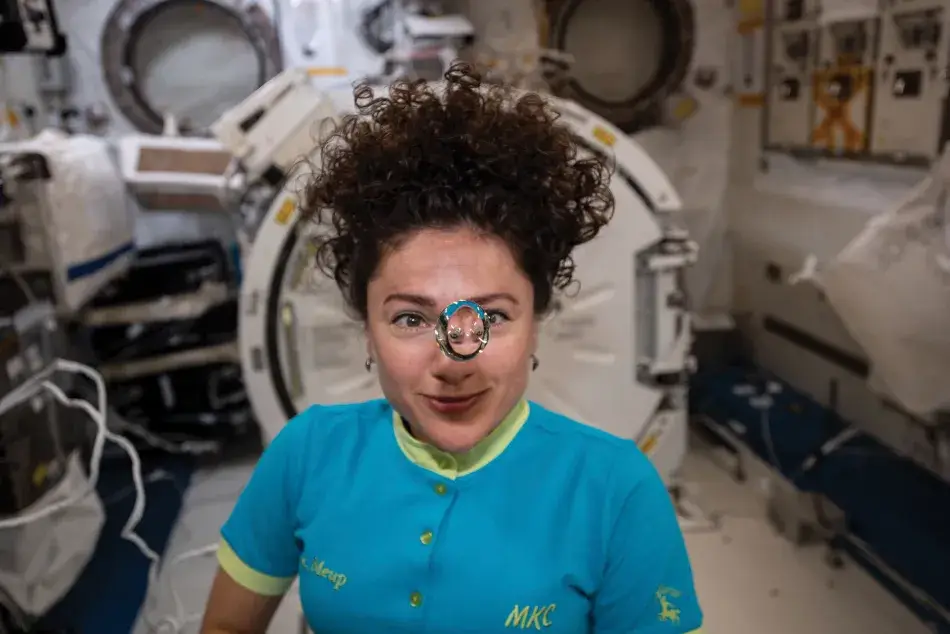
Keating: I would hate to see the roaming charges when you came back to Earth. Now, because you’re such a high-profile, prominent individual as a scientist and an astronaut, every single thing that you would tweet would be scrutinized by literally millions of people around the world. Before we went live, we were joking even about your sock choice. How did that feel to be in this precious bubble of atmospheric pressure and temperature but also under a different kind of bubble of being scrutinized by everyone around the world?
Meir: It is interesting to be on that end. And I think it is something that takes a lot of getting used to. But I try to look at it from the positive side: the source that we can be for outreach and for inspiration and hopefully in serving as role models. I think whether we like it or not, when we put this blue suit on, there are a lot of people that listen. And so it’s important to try to use that for good and to make a positive impact. Outreach to me has always been something that’s very important. When I was a scientist, I was very active in doing that. And because I worked with charismatic megafauna, it made my job even easier. Everybody loves penguins. So it’s an important role. But it is something that you have to think about. You have to be much more careful in the kind of things that you post and the kind of reaction that you might receive from that. I certainly didn’t expect that it was the post of my Menorah socks right around Hanukkah that would generate so much attention.
Keating: So speaking of that and of being an ambassador literally around the universe, we have a question from Azucena, who is in Ms. Meghan’s eleventh-grade biology class at High Tech High Mesa campus. She asks: “how can we imitate the international cooperation and problem-solving that is done on the ISS on Earth?” I remember in January you said one of the things you had to do that was a challenge is learn Russian. How challenging is it? And can we learn lessons here on Earth that would be derived from what you experienced in the international environment of the ISS?
Meir: The ISS is a great example of what we are able to do when we put our differences aside and work together. And I think it can be a very positive role model for many other disciplines and areas on Earth. If you think about the state of our political relationship right now with our main partner on the International Space Station, which is Russia, and all of these international partnerships, to me it is simply an amazing thing and something that I appreciate, to see what we can accomplish when we work together side by side with our Russian counterparts. As I mentioned, I launched on a Russian spacecraft. I spent a majority of the two years before space flight training, living, and working at the cosmonaut training center outside of Moscow. And it was such an incredible, exceptional opportunity and experience to do that.
I really do hope that this can be a positive model to show what can be accomplished when we work together. And I think when we are up there together as international crews, we immediately, without even a thought, put aside all of those differences. We see ourselves as a crew working together. And that’s another thing that the vantage point of space offers. When you look down from above, seeing Earth in all of its entirety and how interconnected it is, it is so easy to see that we’re truly one. We’re one human. We’re all in this together. I do hope that there are many other things that we can do on the ground as scientists, collaborating internationally. I was a student at the International Space University before becoming an astronaut. When we solve a problem with lots of different types of input, that’s when we have the best solution.
Keating: Absolutely. I believe the word “scientist” in Russian translates roughly into “someone who was taught,” or “someone who was instructed.” One of our listeners asks: “what advice do you have for university students or students in general aspiring to have a career like yours?”
Meir: Well, in terms of becoming an astronaut or working at NASA, you need a degree in a STEM field: science, technology, engineering, math. Whether it’s being an astronaut, being a support person at NASA, working in mission control, being the one to design and build the rocket, or just monitor all the different systems. That’s really the foundation. But I think the biggest piece of advice is making sure that you are following what you are passionate about. I really believe that is the only way to excel. If you don’t love it, you’re not going to excel at it, and you’re not going to be happy doing it. And, of course, you have to persevere. There will be a lot of times when you fail along the way. You have to be willing to take that risk and to push yourself further and go a little bit outside of your comfort zone. That is when the great things really happen and when you learn the most valuable lessons.
Keating: In the years that I have been doing my podcast, the two most common words a person says before “It was the best thing that ever happened to me” are “I failed.” And that reminds me of something you said back in January, that you actually learned a lot from the failures. And you didn’t let them be final in terms of your aspirations. So how do you stay motivated through setbacks, failures, and just the duration that it takes to get to this pinnacle of becoming a NASA astronaut?
Meir: I think it goes back to passion. I had this dream since I was five years old. I applied to become an astronaut before I was selected. And I wasn’t selected. I went through the whole interview process, got to the final round, and was rejected that first time, which is a pretty big hit. There’s a big investment there. But if you don’t get back on that horse, as they say, if you don’t apply again, then it will never happen. And I think that’s what kept me motivated in the background, knowing how passionate I was about this and also having the support from my friends, my family, my mentors, and having people reinforce that idea. They knew that this was what I wanted and that if you put your mind to it, you can really achieve anything. I think that process of finding a good mentor and then for people like you and for other scientists to be a good mentor, how truly that can change someone’s course and make the greatest impact.
Keating: That question was from Herbert Hoover High School here in San Diego. Another student there, Joel in the eleventh grade, asks, “how do you feel about the privatization of the space industry and rockets being manufactured by private enterprises as opposed to NASA?” I have a mug from SpaceX. But I note that most of the popular clothing I see nowadays has NASA emblems. It’s the strongest brand in the universe as far as I’m concerned. How is that affecting NASA?
Meir: NASA seems so hot right now. And this privatization is very important. I think it’s great that more and more entities are getting involved. I think it’s a little bit of a misnomer in that some people think this privatization is us working against SpaceX or a competition. As you know, we’re really working together. SpaceX is building us these vehicles right now under a NASA contract. So it’s a NASA-funded mission. And it’s really a partnership between the two of us. And it’s very important in the way that space programs have been doing business. Because space flight is incredibly costly and incredibly risky. I don’t think any country right now has the budget to do everything on its own. So what we have to do is outsource and work together with private companies, including through international agencies and companies.
And it is making space flight more accessible to everyone. Whether it’s a Virgin Galactic suborbital flight, or some of these companies that might not necessarily be sending people to the space station but are making some aspect of space flight more accessible to more people. The more involvement that we have in this, the better off we are to truly become a space-faring species.
Keating: This next question is from a student: “Thank you for being a role model. It’s been a privilege to follow your NASA journey. I read your 2019 paper on the way reduced metabolisms support hypoxic flight in bar-headed geese and I’m wondering how do you envision applying your research from the scientific side of Jessica to the astronaut side of Jessica?”
Meir: I think the most important thing that I can take from my career as a scientist and how I approach things now as an astronaut is really the scientific manner of thinking: meaning, critical thinking, and problem-solving. When we become astronauts, we really do give up our previous career, but we draw from all of those very valuable lessons that we learned along the way. And just being able to stop and think in order to solve a problem critically and to evoke all of those insights that we had from the scientific method and process I think are really important to how you approach any problem. As a scientist on the space station, we are operators doing different types of experiments, which I showed you briefly earlier. But I hope that as a scientist, if I do need to provide some kind of insight to the investigator on the ground, my scientific background will help me – that power of observation that we are so keen to amplify as scientists.
Keating: My late colleague Sally Ride was a professor in the physics department with me here at the University of California San Diego. She was the first woman from America in space. And, of course, you did the first all-female spacewalk with Christina. I see a lot of questions coming in about the pressure that you must feel to not only do your job as a scientist and as an astronaut, thinking about safety, and so on, but also as a role model. How do you wear so many hats at once? I assume your dive training suited you to high-pressure situations. But how do you handle the added pressure of being a role model as well?
Meir: It’s hard sometimes to remember and to realize that I am on that side now. Because I remember looking up to so many astronauts when I was a kid and all throughout my life. And it was this iconic blue flight suit that I saw, that was what I wanted to emulate and wear. And when I got my first blue flight suit and put it on, it was shocking to realize that now I’m the person on this side. And sometimes still when I’m doing an event like this or talking to a school, I almost do this little flip in my brain and think, “Wait a minute. I’m the person up there now?” And so I think it’s just a natural transition that happens. That’s what happens in your life when you get to this level. And you need to appreciate that.
The spacewalk that you alluded to, that was an interesting process for me. Spacewalks are the most challenging thing that we do as astronauts. They’re the riskiest thing that we do and the most challenging both mentally and physically. They demand all of your concentration. When I went out of the hatch that day, especially for my very first spacewalk, I was 100 percent focused on the task, making sure that we are going to get our job done safely and successfully and keep ourselves safe as well. Again, it is the riskiest thing we do. So, at the time, I wasn’t really thinking about that added historical significance. I was able to process that more after the fact. And that’s when it really set in how important it was. Now, at first, I think I kind of shied away from this. Why should it matter? We’re just out there doing our jobs. It doesn’t matter if it’s two men or two women or one woman and one man, we’re all up here with the same amount of training. But then I really realized how important it was. And I think for both Christina and me, it wasn’t a personal achievement for us. It was really an event that paid homage and tribute to these generations of women and other minorities that were the ones truly breaking those glass ceilings and pushing those frontiers. Like Kathy Sullivan, as you mentioned, being the first woman to do a spacewalk; it was those generations and those people who enabled us to be where we are at the point today where there is more than one woman on the space station. It makes sense that it just happened to be an all-female spacewalk. And so that to me is the most important part that should be celebrated. It’s really about those generations that came before us. And now it’s our turn to help keep that inspiration, to serve as those role models, and to pay it forward.
Keating: It reminds me of something Sally Ride said to me a long time ago: all astronauts should be women because they have a higher strength-to-weight ratio than men. But we won’t get into that . . .
Meir: And a lower metabolic rate.
Keating: That’s right.
Meir: The reason why Christina and my spacewalk lasted so long was because we were not limited by the CO2 scrubbing.
Keating: Although wasn’t it true that you didn’t have proper-fitting suits?
Meir: Yeah, that did come out in the media a little, but it was a little bit misrepresented. All of the space suits right now, I’ll tell you, are too big for me. We have to learn how to work in the space suits that we have because they’re really an anachronism tied to the past. Those space suits were designed in the 1970s. The astronaut population back then looked a lot different than it does now. We’re still stuck with those same suits because of the amount of time it takes to develop the technology, the budget, and then to get those suits up there. The good thing is that the suits that we’re designing for the future will actually be built for a small person. And then we scale up. The first prototype that we have right now is ideally suited for people around my size or even smaller.
And so that’s a big difference, that we’re able to approach it from that side. And these suits will accommodate a range of sizes from the fifth to ninety-fifth percentile. So we will be covered in the future with these suits, which will also have a lot more mobility and be much easier to use.
Keating: As part of the ninety-ninth percentile, I’m looking forward to that. Just a question, my own curiosity, while I have the opportunity. Do you dream differently in space? Do you have more vivid dreams? Is it any different than being on Earth?
Meir: I didn’t notice a perceptible difference, not at least in the things that I remembered. People do often ask, are you floating in your dreams or are you in gravity? I think that for most of my dreams I was still in gravity. I was either walking or biking or doing something that did involve gravity. So I didn’t notice really a perceptible change.
Keating: Thank you to all the students who participated in this discussion. Now we’re going to take some questions from some older people. The Academy’s Public Face of Science report on Perceptions of Science in America tells us that people’s lived experiences shape their relationship to climate change. They see erosion or they experience hurricanes, and the problem becomes more magnified and real to them. In your experience, both in Antarctica where you were witness to the freezer of the planet and also looking down on Earth from this isolated bubble in space, how did that affect your own perspective of the climate crisis?
Meir: That’s something that I thought about a lot before even going to space. I’ve always been very environmentally minded. It’s always been a very important issue to me. For a lot of other astronauts, it did change them. Maybe they were people who hadn’t thought a lot about climate change in the past. So they noticed a drastic difference after looking down, having that privilege to see Earth from above. But you see that very thin, tenuous band of an atmosphere and how beautiful it is and how fragile it is. And you know that you have to protect it. You can even see the gradient of the different blues as the atmosphere gets thinner and thinner with altitude. You see the interconnected land masses and the oceans. And you just know that it is so special. You’re looking around in this void, in this blackness of space. We have one home. And with that interconnected component, we are all in it together.
I think for me it made all of that resonate even more loudly. As I mentioned, I thought a lot about the environmental aspect, but that interconnected aspect was something that really resonated from looking down. You look at Earth, and you don’t see any of these man-made political boundaries that we’ve imposed upon ourselves. It is one planet, and it is our home. We know that we need to protect it.
Keating: Another report from the Academy’s Public Face of Science initiative, on Encountering Science in America, says that people’s trust in science is based on their cumulative experience with science over the years. Oftentimes I get the impression that people see us scientists as specialized people doing specialized things. It’s not really relevant to them. It’s maybe interesting, but it’s not for them. And you, especially as a scientist and an astronaut, having done the most specialized thing perhaps in the universe right now, have a really unique perspective. I wonder, do you see ways that we can improve, increase, and enhance the public’s enthusiasm for science generally and for space in particular?
Meir: I think that is very important. I’ve always said that one of our biggest roles as scientists, as astronauts, is as these ambassadors for science to communicate that kind of understanding to students and to the general public. My science was all federally funded from the National Science Foundation. My role as an astronaut is also federally funded. I’ve always said that if as a scientist or an astronaut, I can’t explain why it is that what I’m doing is important or why we’re doing it, then we really shouldn’t be doing it at all. And I know that a lot of scientists historically have had a problem communicating. We have, as you mentioned, this kind of lofty attitude or maybe we can’t quite relate ourselves or our research and what we’re doing to the masses. But it’s critically important to do that.
I think the newer generations are getting better and better at it. We have a lot of new technology that helps us communicate more widely. But it is incredibly important that we keep doing that. I feel that way about my mission. I just wish so badly that all the humans on Earth could see what I saw, because as you said, accumulating that kind of science and experience makes you understand and gives you an appreciation for it. And if everyone could see Earth as I was lucky enough to from above, it would give us the perspective needed to solve these kinds of problems with the environment and with our current global crisis with this pandemic. So the best we can do is share it and have meetings like this one and show the imagery and talk to people and try to educate as much as we can and try to emphasize that science is real. It is fact.
And as Neil deGrasse Tyson loves to say, the thing about science is that it’s true whether or not you believe in it. And I think that’s the thing for me that I have trouble with right now, this problem of accepting science and believing in science. I understand that people have different beliefs. But science isn’t a belief.
Keating: A youngster who I happen to know personally by the name of Elijah Keating asked, “what’s your favorite thing to eat in space?” And I guess he means favorite food that’s kosher.
Meir: We have a whole food lab at NASA now and so our menu is very extensive. I would say some of my favorites are the newer foods like Indian fish curry and Turkish fish stew. I love the butternut squash, the sweet and savory kale. And then we also get to have food from our Russian and other European counterparts. I loved having the tvorog and even the ryazhenka, which are some interesting things with dairy that the Russians do.
Keating: See if Postmates would deliver. I have a question now from Carol from Colombia, South America. She’s about to finish school and wants to study astronomy. But in her country, it’s not a career that is easy to enter. Her question is what advice would you give to all those young people who are afraid to study what they love because in their country it’s hard to get a job in that field?
Meir: I would say persistence is what you need. If it’s something that you know you want, you have to try to find a way to make that happen. And it might sound easy for me to say that, growing up in the United States. I had a lot of opportunities that simply are not available for everybody. But if you can try to do the research, try to find whatever avenue you can take to get as close to that opportunity as you can, you will be happy in the end if you are able to be involved in that thing that you love so much.
Keating: A quick question here from Eva Fowler. Because of your view of planet Earth, what are your views of going to planet Mars?
Meir: I would love to go to Mars. But I would hope my next destination is the moon. That really is the next realistic step. It’s the way we do things here at NASA. We’ve got to be incremental about it and demonstrate all of these technologies and how we will sustain a presence farther away. The moon is 250,000 miles away. The space station is only 250 miles. So I’m further from you now than when we spoke when I was on the space station. The moon is another leap. I hope to be on one of the Artemis missions. We are planning those missions now to send the first woman and the next man back to the moon. And then hopefully onto Mars as well. Once we figure that out, once we have the mission infrastructure ready, I’ll be ready to go.
Keating: I’m going to take my moderator prerogative and ask you a question I’ve been dying to ask you. Speaking of the moon, you may have seen Stanley Kubrick’s adaptation of Arthur C. Clarke’s 2001: A Space Odyssey. I’m not going to ask about your relationship to HAL. I’m not going to get into that. But these astronauts encounter this mysterious monolith, which was previously seen by these hominids on the savannahs of Africa. And it’s supposed to represent a time capsule or some machine to convey wisdom or knowledge that will last until human civilization is mature enough to decipher this message within. I want to ask you – and I also asked this of Ann Druyan who did this on the Voyager mission, she put a record on it – if you had a billion-year, long-lasting time capsule, what would you put in it? What would you do with it if you knew it would be transported one billion years into the future?
Meir: That is a difficult question. I would say definitely some way to record some of these basic scientific principles that we rely on for everything that we do, some kind of documentation of all of our big discoveries, the things that we think are the most important from our civilization. But I would absolutely include music and the arts. It’s not just about STEM, it’s about STEAM now. I think integrating arts with the sciences helps us solve problems in a different way and elaborates and brings things out in a whole new light. So, I would definitely include some classical music, some jazz music, some modern rock, all the way through. What else? I’m going to have think about that one for a while.
Keating: Maybe I’ll get you on the podcast, and we can spend more time on it. Last couple of questions. Do you have a role model? Do you have a particular person outside of your family who was a role model to you?
Meir: I have had so many. It’s hard to pick just one. But my family, my siblings and my parents were big ones. All of the astronauts that I saw growing up. I remember meeting John Glenn when I was graduating from Brown University. The first astronaut I ever met was Charlie Duke. All of the female astronauts, of course Kathy Sullivan doing that first female spacewalk. So many people have inspired me in my journey.
Keating: Well, Jessica, I want to thank you for being a role model to me and to millions around the world like me and being so gracious and accommodating with your time, your experiences, and your shared wisdom.
© 2020 by Jessica Meir and Brian Keating, respectively
To view or listen to the presentation, visit www.amacad.org/events/astronaut-meir.
